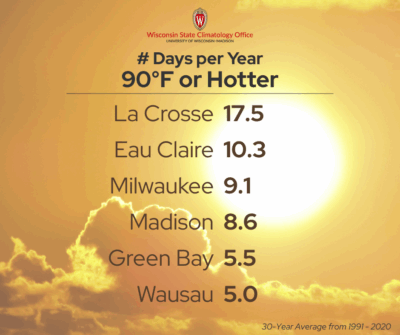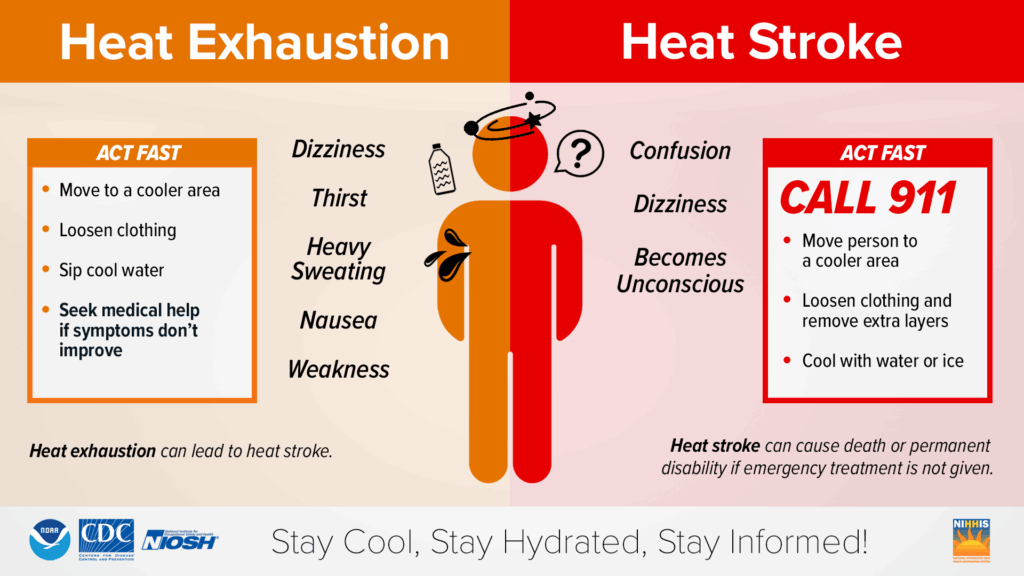The forecast for late June is calling for sizzling temperatures and Florida-like humidity. Even Ironwood, Michigan, just across the Iron County border, is expecting 90-degree heat this weekend — something the citizens there typically experience only once or twice a year! These steamy temperatures fit into a longer pattern of hot Junes and a rising trend towards warmer nights.
Most Wisconsin communities experience their first 90-degree temperatures of the season during the month of June, with the highest number of 90-degree days occurring in July.
Of Wisconsin’s six first-order cities, La Crosse typically sees the most 90-degree days, with an average of 17.5 per year.

Trends in Summer Heat
While we thank Willis Carrier for his gift of air conditioning this summer, you may be surprised to find that Wisconsin hasn’t seen a rise in hot days (90 degrees or higher) since the invention became widely available. The average number of hot days in the state has stayed near 10 since 1950.

However, if you are fortunate enough to have it, you likely get more use out of your A/C unit at night than you would have in the 1950s!
Wisconsin has seen a steep rise in the number of very warm nights (70 degrees or higher), with the average increasing from about three nights per year in 1950 to nearly eight nights in 2024.
This trend is likely caused by the greater amount of moisture in the atmosphere in our warming climate. Since water is a good insulator, humid air retains heat better than drier air (think of how a lake stays warm in the fall even as air temperatures get cooler).
Due to that, nighttime temperatures usually don’t fall as much when it’s humid. On the other hand, during the day, higher humidity typically creates haze, clouds, or precipitation, which can limit daytime highs.

As Wisconsin cities become more urbanized, a nighttime heat island effect could also contribute to this trend of warmer nights.
Impact on Health
Climate and Health Program Manager at Wisconsin Department of Health Services (DHS), Kate Beardmore, says that in a summer heatwave, allowing your body temperature to cool down at night is essential for the body’s basic functions.
Not only do high overnight temperatures impact our ability to fall and stay asleep, but they also impact sleep quality and overall health. High overnight temperatures pose a significant health risk, potentially leading to heat exhaustion, heat stroke, and even death. — Kate Beardmore
Heat-related illnesses themselves can be sneaky, as their symptoms are not always obvious or are similar to those of other illnesses. It’s important to listen to your body and pay attention to any feelings that may be out of the ordinary. Be sure to keep an eye out for symptoms in children or animals in your care as well.

Beardmore says that heat doesn’t affect everyone equally. Variables like age, body type, occupation, and health conditions can impact how at risk someone is. You can learn more about heat vulnerability on the DHS extreme heat page.
211 Wisconsin can help you find a cooling shelter near you if you don’t have A/C at home.
If you do plan on being outside in the heat, Beardmore gives this advice:
First and foremost, stay hydrated! Drink lots of water and try to avoid drinks high in caffeine, sugar, sodium, or alcohol, as these can cause you to lose more body fluid. Do what you can to avoid the hottest parts of the day (midday). Stay in the shade and take breaks, preferably in an air conditioned space. Loose light colored clothing helps too. — Kate Beardmore
Don’t wait until you’re thirsty to grab the water bottle, either! The Centers for Disease Control and Prevention recommends you drink eight ounces of water every 15 to 20 minutes when you’re outside in extreme summer heat. Stay safe out there!
This is a product of the Wisconsin State Climatology Office. For questions and comments, please contact us by email (stclim@aos.wisc.edu) or phone (608-263-2374).